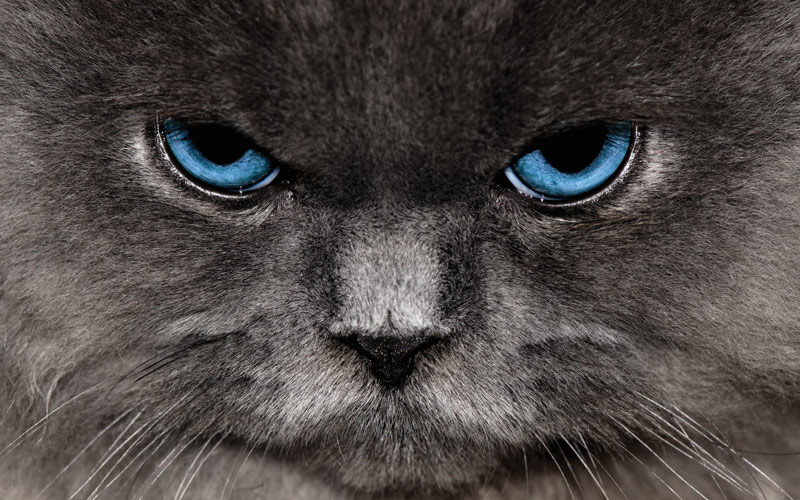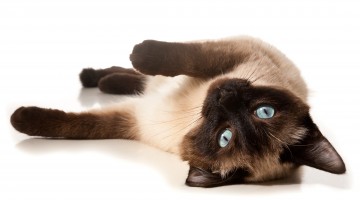YOUR CAT COMMUNICATES AS MUCH WITH HIS BODY LANGUAGE AS WITH HIS VOICE. LEARNING HOW TO INTERPRET THE SUBTLEST OF SIGNALS WILL ELIMINATE MISUNDERSTANDINGS AND STRENGTHEN YOUR BOND.
While I was working one day, Natasha, my feline diva, assumed her usual “office manager” position by sitting in my lap with her front paws draped over my left forearm. I petted her as I read something on the computer screen. Suddenly, she bit my wrist and threw in a terse hiss for emphasis.
This didn’t just happen out of the blue. On reflection, I realized that while I was petting her, I wasn’t paying attention when the fur on her back rippled and she glanced over her shoulder at me with a “please stop” expression on her face. Her tail was also slapping my leg with increasing intensity. In short, it was my fault I got bitten, because I didn’t take heed of Natasha’s warning signals.
WARNING POSTURES
“Feline communication is primarily based on body language, with body, tail and facial posturing,” says veterinarian Dr. Ilona Rodan. “Most communication between cats is to prevent altercations over territory and food, and to avoid physical fighting to prevent injury. Only when a cat, other animal or human doesn’t understand or ignores the posturing, will vocalization occur.”
“When a cat communicates, she engages her whole body and many of her systems come into play,” says Darlene Arden, Certified Animal Behavior Consultant. “Reflexive responses to fear or aggression are displayed in physiological changes like dilated pupils, flattened ears or raised fur.”
1Look at your cat’s beautiful eyes, and think of them as his mood ring. A cat’s pupils vary in size and shape for many reasons, ranging from emotions to light levels. Narrow pupils usually mean a contented kitty but “often pupils change in an angry cat and slits generally mean trouble,” warns veterinarian Dr. Deb Eldredge. Dilated pupils may mean your cat’s eyes are adjusting to low light levels – or it may mean he is fearful or agitated.
2With 32 muscles, cat’s ears are remarkable. Like miniature radar dishes, they swivel independently of each other, rotate 180°, and move up and down. Ear placement is an excellent mood evaluator. An alert and contented kitty’s ears are up and forward, or swiveling around listening to sounds. “A fearful, agitated or aggressive cat’s ears start up tight at first, then turn sideways and flatten right before a paw swipe,” says Dr. Eldredge. Remember, the flatter the ears, the angrier the cat. “Vocalization, like growling, hissing or spitting, can also be part of the repertoire,” says Darlene.
3Your cat’s whiskers or “vibrissae” are specialized hairs that, among other functions, serve as his personal on board GPS system. Of the three sets of whiskers on the face, the muzzle whiskers are the longest. Muscle tissue enables them to move forward and backwards, and those movements are another tool for reading your cat’s emotions. Forward-pointing whiskers indicate a happy cat who may want to play. Whiskers pointing outwards mean the cat is gathering environmental information and may be agitated. Whiskers pulled tightly back signal fear or aggression, and the cat should be left alone.
4The fur and body also communicate mood. When your kitty approaches with her back raised and her fur flat, she wants your attention. “An arched ridge of hair on her back can either be an aggressive display or one of fear,” says Darlene. If her legs are straight, back arched, hackles raised and the fur on her tail and back evenly puffed up, she is overly stressed and attempting to look larger and more threatening. “The smartest thing to do is give this cat space,” says Dr. Eldridge.
5The tail is a communication semaphore and signals many emotions. It may be straight up, out, down or curled around his body; it may be still, gently moving or swishing back and forth. A tail held straight up with a gently moving tip generally indicates excitement. A swiftly slapping tail indicates agitation; this kitty should be left alone. “If her tail is straight up and fuzzy, that’s not cute – it’s aggression,” says Darlene.
Feline body language is complex. We may never completely understand it, but make no mistake – by using body language and over 20 different vocalizations, cats communicate with us. Learning the basic signals, and especially your own cat’s personal subtleties, deepens your bond and strengthens your relationship.
Love Signs
Cats show affection in many ways. We’re familiar with purring, but below are some other favorite non-verbal signs of love.
Eye blinks: In the cat world, these are also called “kitty kisses”. In feline parlance, slow eye blinks mean she trusts you. Blink back.
Head butting: When kitty rubs you with his head, chin or body, he’s not only marking you with pheromones; he’s also demonstrating affection for you.
Kneading: Also known as “making biscuits”, this behavior is a throwback to when your cat was a kitten and used his paws to stimulate milk flow. A kneading kitty is a very happy kitty!
Licking: Another throwback to kittenhood. Mothers groom their kittens as part of their healthcare and cleanliness; adult cats, considering us as part of their clan, may lick us for similar reasons.
Nose kisses: A gentle greeting among feline friends that’s often extended to humans. Some cats add a love bite to the tip of your nose as a sign of extra affection.





No Comment